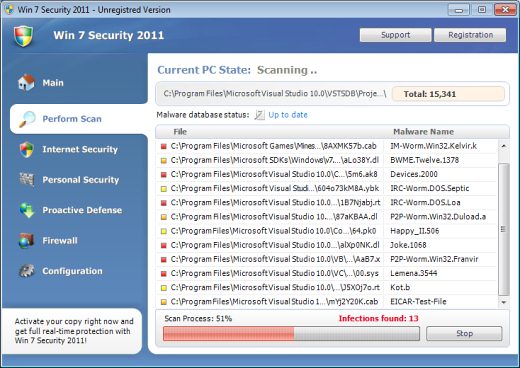
Easiest Removal Option:
Remote Repair: Paying an expert to remove this threat is always the easiest option. It’s also the most expensive. PCTechGuide.com has reviewed several remote computer repair companies and we recommend http://www.pcninja.com This is a small computer repair company (Two brick and motar stores in California ). Small companies like this tend to deliver better customer service. With a fully trained and experienced staff all based in California doing the repairs, you can’t go wrong. The cost for most virus removal services is around $99 USD.
Software Option:
Antivirus Clients: Anti-Virus software was developed to remove these exact kind of threats. Most people who get infected with malware get infected from having no protection or from using a free client that offered no real up front protection. It’s important to secure your computer so know one gains access to it and to protect your identity online.
PCTechGuide.com has reviewed hundreds of software vendors over the years. See our Antivirus Reviews and Internet security reviews for full in-depth reviews.
To Remove this virus we recommend Spyware Doctor with Antivirus or Malwarebytes. All three offer good results in most cases.
Do It Yourself Removal Guide
How to remove Win 7 Security 2011 DIY Steps
Proceed with Caution. PCTechGuide.com offers this information free of charge. We can not be held liable for any actions you take regarding the below information. It is crucial to always have a complete backup of your personal data in order to avoid any major loss. Additionally, installing and enabling a live antivirus protection using a genuine product such as Spywar Doctor with Antivirus may prevent further malware from affecting your system. In case the removal process seems to be too difficult it is always possible to request a remote computer repair session at http://www.pcninja.com.
Step 1. The first and most important step is to stop the Win 7 Security 2011 executable from running. In order to do so there are various steps that can be followed, such as the ones listed below:
A. Reboot your PC and choose to boot into Safe Mode with Networking. While in Safe Mode, Win 7 Security 2011 will no longer automatically start alongside your operating system, reason why its main executable file will be easy and convenient to delete. The file path for this threat is:
XP: Win 7 Security 2011 executable paths:
C:Documents and Settings%User Name%Local SettingsApplication Datapw.exe
C:Documents and Settings%User Name%Local SettingsApplication DataMSASCui.exe
Win 7 / Vista: Win 7 Security 2011 executable paths:
C:Users%User Name%AppDataLocalpw.exe
C:Users%User Name%AppDataLocalMSASCui.exe
B. Browse to the file paths listed above and rename the files so that when you will reboot the PC Win 7 Security 2011 will no longer be running. Once this is done, feel free to simply delete the executables indicated above.
C. While browsing the executable paths indicated in this guide the user has to arrange the files and folders by last modified date in order to list files from the most recently modified down to the older, last modified. In this way it will be easier to identify the infected files, especially if they are named in a different way (in most cases this fake antivirus software generates random names for its main executable files).
D. Open up the Task Manager and locate the processes named according to the executables pointed out in this article. Once identified, stop their running processes and browse to their locations in order to delete them from disk.
Step 2. Delete both files from disk, if not already done so. It is important to remove these files in order to make sure that Win 7 Security 2011 is no longer running (while this fake antivirus software is running, certain key operating system components will be disabled in order to protect the malware’s presence).
Step 3. Download and conduct a full operating system scan using either of the following recommended legitimate antivirus clients: Spyware Doctor with Antivirus or Malwarebytes. Please note that genuine antivirus software recommended by our website is not free to use, however, once installed, you can easily identify whatever additional malware may be still present in the system. In this way, according to the degree of operating system damage already caused, it is recommended to purchase a license of the legitimate antivirus client of your choice in order to be able to remove any other malware in an automatic way.
How not to Get Infected Again
In most cases users get infected with viruses and malware from not having propper up-front protection. Computer security experts recommend that you use an anti-virus client that offers up front protection to block viruses from installing and a security client that keeps up to date with the latest virus defenitions. The paid versions of Spyware Doctor with Antivirus and Malwarebytes fit this criteria. Going with one of these clients is a step in the right direction to protecting your computer.
Need More Help? Want to Say Thanks?
Ask questions or post your comments below. Thank You.
Discalimer: PCTechGuide.com does make money from users who make a purchase of many of the products and services featured on this website.